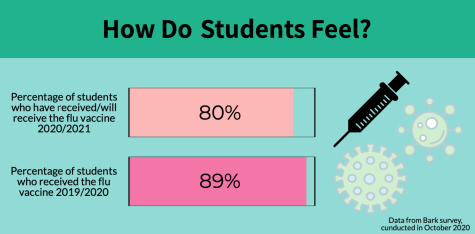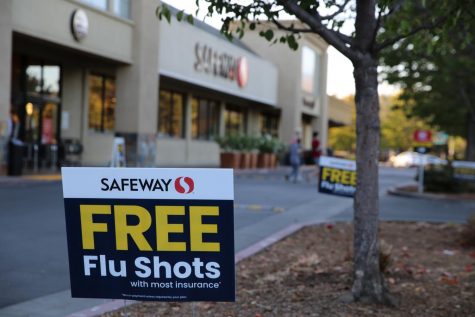In a year characterized by mask-wearing, constant hand sanitization and social distancing, it is still unclear when life will return to normal. With schools across the country slowly beginning to reopen for in-person learning, the threat of yet another outbreak looms in the near future. This incoming virus causes symptoms such as fevers, coughs, chills and a sore throat, to name a few, but it is not COVID-19.

Although generally not as severe, seasonal influenza (the flu) infects millions of people each year, leading to widespread hospitalizations and deaths. Last year’s flu strain killed nearly 80,000 people in the United States, which was the highest death rate in decades, according to the University of California, San Francisco (UCSF). This year’s flu season will be unlike any other in recent history, as COVID-19 will be circulating at the same time.
According to the Centers for Disease Control and Prevention (CDC), documented COVID-19 cases in the United States have surpassed 7 million to date and documented deaths are continuing to rise past 200,000.
According to Dr. Jennifer Babik, an infectious disease physician at UCSF, as of right now, the mortality rate of COVID-19 is 30 times higher than that of the flu.
“The estimate at the moment is that [COVID-19’s mortality rate] is around 3 or 4 percent, whereas with influenza, it’s 0.1 percent,” Babik said.
Although COVID-19 is more prevalent in the media and is generally deadlier, Dr. Thomas Reid, a palliative care physician at UCSF, stresses that both viruses can cause complications and should be taken seriously.
“The flu is also a serious disease, although not one that people often think of in the same way that they think about COVID-19. Thousands of people die every year just in the United States from the flu,” Reid said.

Since the flu and COVID-19 are both contagious respiratory illnesses marked by nearly identical symptoms, it will be difficult to differentiate between the two without a clinical test. This is one reason receiving the common flu vaccination will be more important than ever this season, states Reid. The flu shot is available every year and its effectiveness ranges seasonally from 20 to 60 percent of patients receiving full immunity depending on how accurately scientists have predicted the flu strains, according to UCSF.
Still, there are many people who do not choose to get the flu shot each year. The rationale for this can vary widely, from concern over side effects to a belief that a flu shot may weaken the body’s response to the flu over time. Regardless, the flu shot is critical in the battle against COVID-19, according to Reid.
“Getting a flu vaccine doesn’t do anything specifically to stop COVID-19, but the primary reason…[to get the vaccine] is because the health care system could be overwhelmed by flu cases…[getting vaccinated] will prevent additional pressure on the system,” Reid said.
In Marin, flu vaccination has already begun. To safely administer the flu shot, healthcare providers and local health departments are wearing masks and protective eyewear to ensure that the flu vaccine is widely available to the general public while minimizing the risk of COVID-19 transmission.

Redwood health specialist Deborah Meshel advises that students and community members get vaccinated as soon as possible.
“The earlier the better… Kaiser [Permanente Medical Centers] and all the clinics in Marin are already offering flu shots. A lot of places, like Kaiser, have drive-through flu shot clinics. You just drive up and stick your arm out the window or open your car door, and they give the flu shot right from your car,” Meshel said.
As schools in Marin begin to reopen for hybrid models of in-person learning, the potential dangers of increased spread of both COVID-19 and the flu among students and staff pose an increased challenge. According to Babik, at school, the chances of the viruses spreading could potentially be higher.
“When people are closer together, there is more risk of transmission. Probably with all the steps that are being taken to mitigate COVID-19, [it] may also help lessen the spread of flu as well,” Babik said.
 On Oct. 9, an email was sent out announcing that Redwood will hopefully be returning to in-person instruction at the start of the second semester in January. Meshel believes that, especially now, it is crucial to understand the potential risks and benefits of returning to school and doing so with the necessary precautions.
On Oct. 9, an email was sent out announcing that Redwood will hopefully be returning to in-person instruction at the start of the second semester in January. Meshel believes that, especially now, it is crucial to understand the potential risks and benefits of returning to school and doing so with the necessary precautions.
“There are always risks to any illness. There might be additional risks for COVID-19, but you have to weigh the benefits with the risks. If schools take precautions with social distancing, mask-wearing, handwashing, air filtration, reduced class sizes and going back to hybrid, then that will be more manageable and [have] less risk,” Meshel said.
In Marin, multiple elementary and middle schools have already re-opened with a restricted schedule, including Neil Cummins, Cove elementary schools, Hall Middle School and more.

Meshel believes this is the case because students in lower grade levels can stay in the same cohort throughout the day, reducing the potential wider spread to more students and teachers. For high schoolers, alternating class periods make the process more complex.
“The high schools tend to be more conservative because it is easier to do distance learning through high schools; the students are older, can be home on their own without parental supervision and are more independent with their work. Plus, the class sizes are much bigger, and there is more intermingling between classes [in high schools],” Meshel said.
Marin health officials are urging residents to get vaccinated before the flu season begins, as it takes 2 weeks to go into effect.
The flu vaccine is available not only through medical providers but many retail establishments like Rite Aid, Safeway and Walgreens and, in many cases, is offered free of charge.












